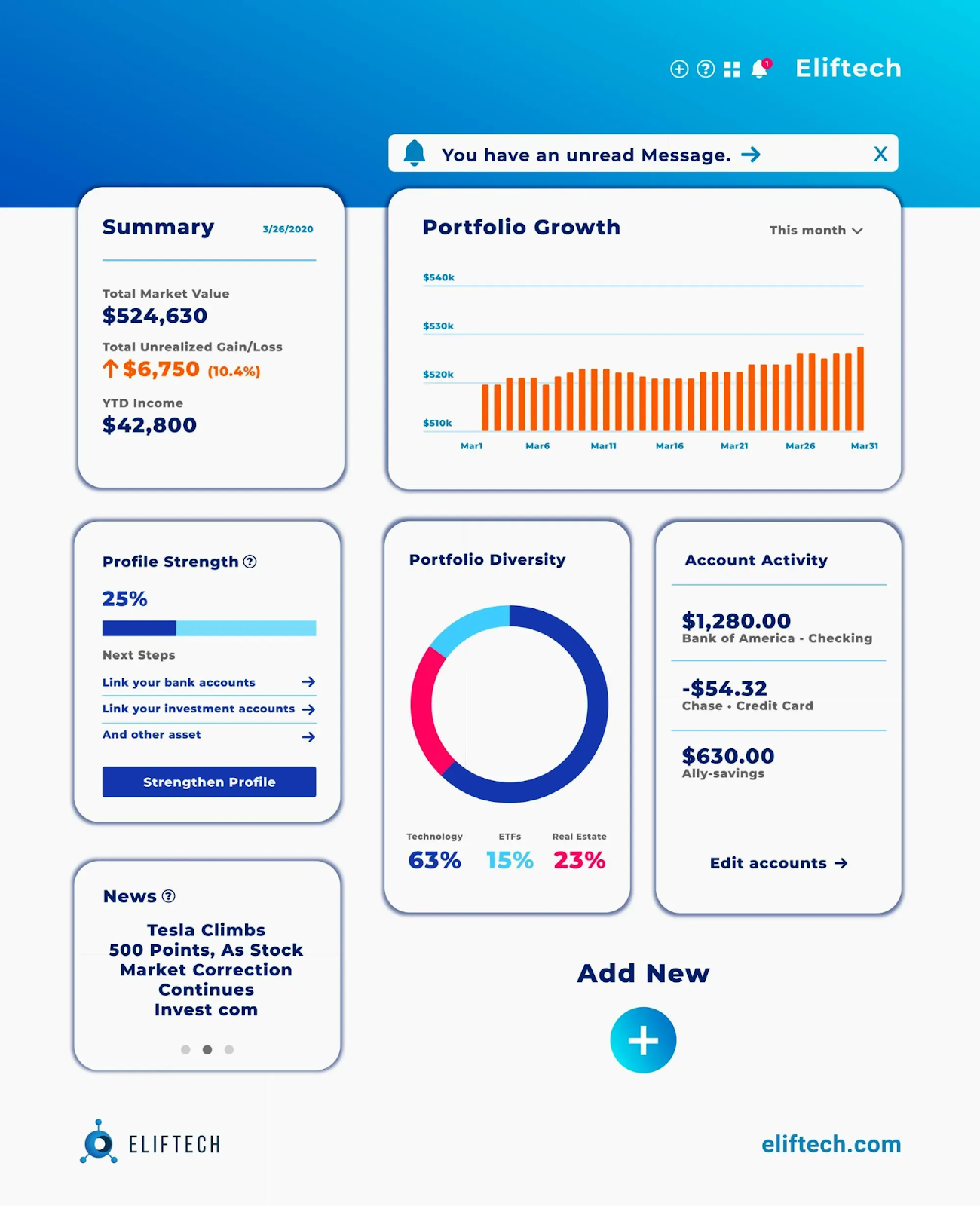
In 2025, fintech apps are reshaping how users interact with their finances. Generic dashboards and static recommendations no longer cut it. Today’s customers expect real-time relevance, personal insights, and value-driven experiences. Enter AI-powered personalization, the engine that drives intelligent engagement and customer loyalty.
Financial technology platforms are now combining machine learning, behavioral data, and predictive analytics to craft deeply personalized financial journeys. This isn't just a trend, it's the foundation of how fintech will build long-term user relationships.
Why AI-Powered Personalization is a Game-Changer for Fintech
Tailored Content and Services
Personalization is no longer just about calling someone by their name. Fintech platforms now curate entire experiences—customized dashboards, pre-approved credit limits, personalized EMI plans, and investment suggestions—all based on user income, risk appetite, credit history, and spending habits.
AI-powered personalization uses behavioral data, transaction histories, device usage, and even sentiment analysis to adapt content and services. Whether it’s nudging a savings goal or suggesting a new investment option, the impact on user engagement is significant.
Real-Time Decisioning
The best personalization is instant. AI engines in fintech apps now make real-time decisions. Instead of relying solely on past behavior, they adapt to current interactions. This means showing a relevant offer, message, or alert right when the user needs it and not an hour later.
Omnichannel Consistency
Users engage with fintech services across multiple touchpoints such as mobile apps, websites, SMS, and emails. AI ensures a consistent, seamless experience across all channels. This coherence reduces friction and increases user engagement.
Predictive Targeting
With access to massive behavioral datasets, AI models can predict what a user might need next. Whether it's a retirement plan recommendation or an overdraft warning, predictive models anticipate user intent, empowering fintechs to engage proactively.
Hyper-Segmentation
Forget broad customer segments. AI can create micro-segments based on psychographics, real-time behaviors, and emotional triggers. This allows for more precise targeting by offering a financial product to a user just before they even realize they need it.
Enhanced Customer Support
AI-driven chatbots and virtual assistants don’t just answer FAQs. They extract user intent and emotion using Natural Language Processing (NLP), ensuring responses are accurate and empathetic. This enhances satisfaction while freeing up human support for complex cases.
Practical Examples of AI-Powered Personalization in Fintech
Personalized Financial Planning
Apps use AI to analyze income, spending habits, debt levels, and life goals to provide users with dynamic, personalized financial roadmaps. This includes:
- Goal-based investment suggestions
- Flexible EMI plans
- Dynamic risk-adjusted savings plans
Gamified Loyalty and Rewards

Gamification drives behavior. Fintech platforms now offer game-style rewards powered by AI, including real-time challenges based on spending habits, tier-based progression systems, and surprise incentives. Hyper-personalized rewards based on transaction history boost retention.
Financial Wellness Nudges
AI-powered nudges help users avoid bad decisions and take positive steps. Examples include:
- Notifications before potential overdrafts
- Budget reminders during high spending months
- Recommendations for better savings plans based on seasonal patterns
These micro-interventions improve loyalty and long-term user engagement.
Contextual Upselling and Cross-Selling
Fintech apps use contextual cues for real-time upselling:
- Offer travel insurance after detecting flight bookings
- Recommend mutual funds right after salary deposits
- Suggest top-up loans based on recent credit card activity
This kind of AI-powered personalization increases conversions and makes promotions feel helpful rather than pushy.
How Fintech Apps Are Doing It Now

Customized Dashboards and Offers
Most fintech apps now display home screens that change dynamically. For example:
- High spenders see savings tips
- Frequent travelers see travel loan offers
- Credit score watchers are nudged to try monitoring tools
Credit offers are tailored based on salary data, credit behavior, and online footprints.
In-App Behavioral Analytics

Apps analyze user behavior at every level: feature usage, session length, navigation paths. If someone checks their balance daily but never explores savings features, the app can adjust its layout or recommendations to drive deeper engagement.
A recent study found that 76% of fintech apps now use AI for interface personalization, and time spent on personalized sections is 34% higher than on static ones.
Geolocation-Based Offers
Location data fuels smarter personalization:
- Show branch-specific offers
- Promote auto loans at car dealerships
- Send credit card promos in malls or airports
It also adds a layer of fraud protection, verifying transactions by location.
Leading Examples in the Market
- Kotak Mahindra’s Keya: AI chatbot for account balances, statements, and bill reminders
- SBI’s SIA: Conversational AI (text and audio) for resolving banking queries
- IIFL Finance x Chat360: AI chatbots handling gold loans, business queries
- NerdWallet: Offers personalized credit cards using advanced AI
- Capital One: Uses AI to deliver targeted financial product suggestions
- Wealthsimple: Saved $1M annually through AI knowledge systems
- Super.com: Achieved 17x ROI using AI to unify content and customer support
These examples show that AI is not just about automation but more about personalization at scale.
What’s Next for Personalization in Fintech
Zero UI Personalization
Soon, personalization will extend beyond screens. Voice commands, gestures, and even biometric data will help deliver truly frictionless experiences.
Hyper-Automated Content
Generative AI will create thousands of content variants on the fly—adapting imagery, messaging, and CTAs for individual users based on data profiles.
Financial Digital Twins
Imagine an AI-powered avatar that simulates your future financial scenarios and offers personalized guidance. This is already in development by multiple fintech innovators.
AI Video Personalization
Platforms in India are experimenting with real-time personalized video content—custom greetings, alerts, and offers rendered as short clips. Early results show a significant bump in click-through rates.
AI-powered personalization has moved from a novelty to a necessity in fintech. It enhances every user interaction, increases satisfaction, and builds loyalty. From gamified savings to predictive insights, these tools make finance feel personal, intuitive, and empowering.
As competition heats up, the brands that win will be those that leverage data not just to target, but to understand and serve.
Want to learn more about how AI is scaling industries and businesses? Stay tuned!
FAQs
1. What is AI-powered personalization in fintech apps?
AI-powered personalization refers to using machine learning and predictive analytics to tailor app experiences to each user. In fintech apps, this can mean customized dashboards, spending insights, credit recommendations, or financial tips based on a person’s unique behavior and goals.
2. How does AI improve user engagement in fintech apps?
AI helps fintech apps analyze real-time user data, like transactions, savings patterns, or investment behavior, to deliver relevant notifications, offers, and insights at the right moment. This relevance keeps users active, increases app sessions, and builds long-term trust.
3. What types of personalized features can fintech apps offer with AI?
Common features include:
- Smart budgeting and saving suggestions
- Personalized loan or credit card offers
- Investment portfolio recommendations
- Fraud alerts tailored to user activity
- Contextual tips delivered in-app or via push notifications
These features make the app feel like a proactive financial assistant instead of a static tool.
4. Is AI-powered personalization secure for sensitive financial data?
If implemented correctly, yes. Leading fintech apps combine AI with strict security measures such as encryption, secure APIs, and privacy-by-design principles. They also anonymize data when training AI models to comply with regulations like GDPR or local data-protection laws.
5. How can fintech companies measure the success of AI-driven personalization?
Key metrics include higher daily or monthly active users, increased session length, improved retention rates, greater product uptake, such as loans and investments, and higher customer satisfaction scores.







.png)
.jpg)
.jpg)



